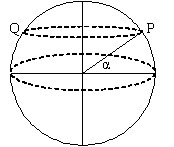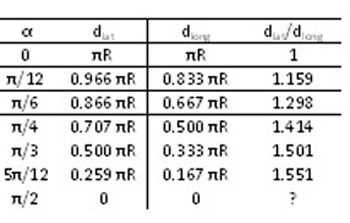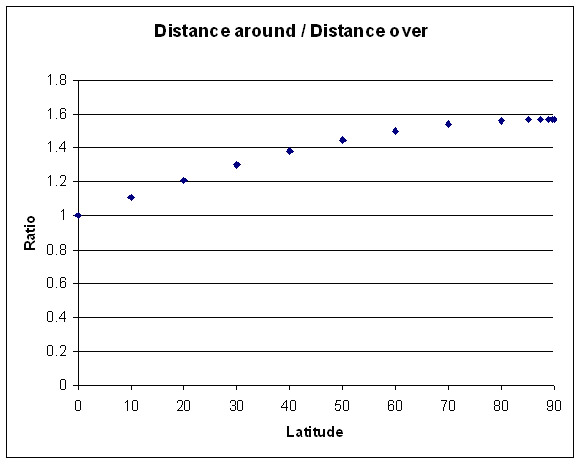Copyright © University of Cambridge. All rights reserved.
'Over the Pole' printed from https://nrich.maths.org/
Show menu
Simon from Elizabeth College, Guernsey and Andrei from Tudor Vianu National College, Romania have both solved this problem and both solutions are used below.
 |
To solve this problem we shall consider that the point is
situated at latitude $\alpha$. To travel around the line of
latitude, the distance from P to Q would be half the circumference
of the circle at latitude $\alpha$. This circle has a radius $R
\cos \alpha$, where $R$ is the radius of Earth.
So, the distance traveled from P to Q on the line of latitude
is $d_{lat} = \pi R \cos \alpha$.
|
|
Traveling over the line of longitude, the circle on which we
have to calculate the distance is a great circle of the sphere, and
the angle of displacement is $2(\pi /2 - \alpha)$ radians. The
distance is therefore $4\pi R(90-L)/360$ where $L$ is the angle of
latitude in degrees or equivalently $d_{long} = 2R (\pi/2 -
\alpha)$.
It is clear that the path on a great circle is always
shorter.
|
 |
 |
A graph of the ratio of these distances shows that this ratio
seems to tend to $\pi /2$ as the line of latitude approaches the
pole, that is the ratio $${d_{lat}\over d_{long}}= {\pi R \cos
\alpha \over 2R (\pi/2 - \alpha)}$$ tends to a limit as $\alpha \to
\pi/2$.
This ratio can also be written as $${d_{lat}\over d_{long}}=
{\pi R \sin (\pi/2- \alpha) \over 2R (\pi/2 - \alpha)}.$$ As we
know ${\theta\over \sin \theta} \to 1 $ as $\theta \to 0$ we can
take $\theta = \pi/2 - \alpha $ and we see that this limit is $\pi
/2$.
|
Andrei calculated this limit using L'Hopital's Rule (case
$0/0$): $$\lim_{\alpha\to \pi/2}{\pi R\cos \alpha \over R(\pi
-2\alpha)} = \lim_{\alpha\to \pi/2}{\pi \cos \alpha \over (\pi
-2\alpha)} = \lim_{\alpha\to \pi/2}{-\pi \sin \alpha \over -2} =
{\pi \over 2} \approx 1.57$$